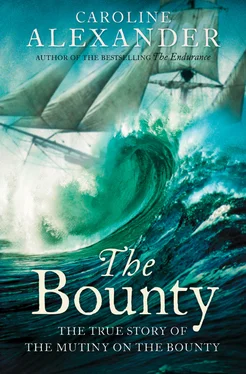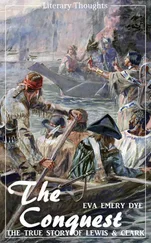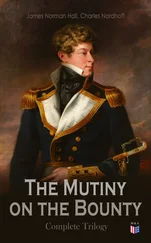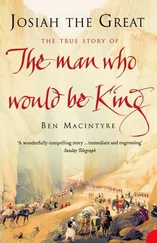Bligh was to serve on his next ship, the Crescent , for three years as a midshipman, or from the age of seventeen to a few weeks short of twenty. This period, which saw tours to Tenerife and the West Indies, was undoubtedly a formative period of his professional life. Paid off in 1774, Bligh next joined the Ranger – not as a midshipman, but once again, initially, as an able seaman; such was the expected fickleness of a naval career. The Ranger ’s principal duty was hunting smugglers, and she had been based where smuggling was known to be particularly egregious, across the Irish Sea at Douglas, on the Isle of Man. Manx men and women were to figure heavily in Bligh’s later life.
Then, at the age of twenty-one, Bligh received the news that would represent a turning point in his life: he had been chosen to join Captain Cook on his third expedition as master of the Resolution. Again, how or by whom he had been singled out for this prestigious commission is not known. Cook himself had stated that the young officers under his direction ‘could be usefully employed in constructing charts, in taking views of the coasts and headlands near which we should pass, and in drawing plans of the bays and harbours in which we should anchor.’ Given Bligh’s later proven abilities, it may be that even at the age of twenty-one a reputation for these skills had preceded him and recommended him to Cook. To work side by side, in this capacity, with the greatest navigator of the age was for Bligh both a great honour and an unparalleled opportunity.
It was also, however, strictly speaking, if not a step backward in the command hierarchy of his profession, at least a step sideways. For a young man of Bligh’s background and aspirations, the desired position following a successful midshipman apprenticeship was that of lieutenant, which would put him securely on the promotional ladder leading to the post of captain. A master, on the other hand, for all the rigour of his responsibilities, received his appointment not as a commission from the Admiralty, but by a warrant from the Naval Board. These were important distinctions, professionally and socially. And while it was not unusual for a young man to bide his time by serving as a master until a lieutenancy was offered, there was the danger of proving too useful in that rank and advancing no further. Most masters had not been young gentlemen and were not destined for the captain’s list. In Bligh’s case the risk seemed justified. If he did his job well, he could count on the ‘interest’ and recommendation of Captain Cook, the most highly regarded royal naval officer of his day as a cartographer and explorer.
With Cook’s expedition, Bligh sailed to Van Diemen’s Land, New Zealand, Tahiti, and the Pacific islands. He patrolled the west coast of North America and searched for the Northwest Passage. Cook was justly famous for maintaining the health of his crew on his long, demanding voyages, and Bligh’s own later practices would reveal that he had closely observed and learned from his mentor’s innovations in diet and ship management.
From Cook’s own log, one catches only glimpses of the earnest young sailing master, usually being sent ahead of the ship in a reconnaissance boat to make a careful survey of some ticklish coast or bay. After Cook himself, Bligh was responsible for most of the charts and surveys made in the course of this last expedition, and had thus honed his already exceptional abilities.
Most unforgettably, Bligh had been present at Kealakekua Bay, Hawaii, when on 14 February 1779, James Cook was murdered by the island natives. The events that led to this shocking tragedy would be long disputed; dispassionate reading of the numerous, often conflicting accounts suggests that Cook behaved with uncharacteristic rashness and provocation to the islanders – but that at the moment of crisis he had been betrayed by the disorder and panic of the armed marines whose duty had been to protect him. In the horrified and frightened aftermath of their loss, Cook’s officers assembled an account of the events at Kealakekua Bay that vindicated most and made a scapegoat of only one man, a Lieutenant Rickinson. Some years later, William Bligh would record his disgust with this closing of the ranks in marginal annotations made in a copy of the official publication of the voyage: ‘A most infamous lie’; ‘The whole affair from the Opening to the end did not last 10 Minutes, nor was their a spark of courage or conduct shown in the whole busyness’; ‘a most Hypocritical expression’; ‘A pretty Old Woman Story’.
In Bligh’s opinion, the principal cause of the tragedy at Kealakekua Bay lay with the marines: they had failed to do their duty. After firing a first panicked volley, they had fallen back from the menacing crowd of islanders in fear, splashing and flailing to their waiting boat. ‘The Marines fir’d & ran which occasioned all that followed for had they fixed their bayonets & not have run, so frightened as they were, they might have drove all before them.’ The person most responsible for the marines’ disorder was their commander, Lieutenant Molesworth Phillips, characterized by Bligh as a ‘person, who never was of any real service the whole Voyage, or did anything but eat and Sleep.’
Bligh was at least in some position to pass judgement, for the day following Cook’s murder he had been sent onshore to oversee a party of men repairing the Resolution’s damaged mast. Shortly after landing, Bligh had found himself faced with a menacing crowd and had ordered his men to stand and fire; and he had held this position until joined by reinforcements from the ship.
The shock and tragedy apart, Cook’s death deprived Bligh of the valuable interest he had counted on at the expedition’s end, and which it would appear by this time he otherwise lacked; his own modest connections had been sufficient to secure him a young gentleman’s entry to naval service, but do not appear to have been extensive enough to have advanced him further. In both the subsequent flurry of promotions and the published account of the voyage, Bligh found himself somewhat marginalized; whether this was because he had made known his highly impolitic views of the expedition cannot be determined. But to his intense annoyance and mortification, the carefully drawn charts he had made throughout the voyage were published under another’s name.
Following his return to England, Bligh had indulged in a rare holiday and returned to the Isle of Man, with, as subsequent events would suggest, a determined objective; only months after his return, in February 1781, William Bligh was married to Elizabeth Betham, the pretty, twenty-seven-year-old daughter of well-to-do and exceptionally well-educated parents. Richard Betham, Elizabeth’s father, was the receiver general, or collector of customs, in Douglas, and the friend of such distinguished men as philosopher David Hume and economist Adam Smith, with whom he had been a student at university. William Bligh, prudent, diligent and ambitious, would have had much to recommend him as a husband. For Elizabeth Betham, intelligent and brought up in a family of enlightened thinkers, Bligh’s participation in a high-profile expedition of discovery and exploration was also an attraction, evidence that the young officer was a cut above the usual naval man. By now Bligh had not only served with, and been deeply affected by, the most progressive sea captain of his age, but also, as his ship logs would reveal, he shared Cook’s unflagging interest in recording not only the coasts and harbours but also the people and places he encountered. As Elizabeth Bligh had undoubtedly appreciated, William Bligh not only was ambitious in the naval line, but also possessed the diligent, enquiring curiosity that might destine him for association with the ‘scientifically’ minded men of the Royal Society.
Читать дальше












